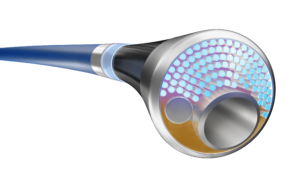 Royal Philips has announced enrolment of the first patient in the US THOR IDE clinical trial, which will study an innovative combined laser atherectomy and intravascular lithotripsy (IVL) catheter.
Royal Philips has announced enrolment of the first patient in the US THOR IDE clinical trial, which will study an innovative combined laser atherectomy and intravascular lithotripsy (IVL) catheter.
Procedures that previously required the use of two different devices can now be performed in a single procedure using a single device, simplifying workflows and procedures and potentially reducing the risk and improving outcomes for patients who might otherwise face multiple complex interventions, Philips says in a press release.
The Cardiovascular Institute of the South in Louisiana recently completed the first case using the new laser catheter. The care team there successfully treated a 78-year-old male with peripheral vascular disease using the Philips device.
“Developing and driving clinical evidence is crucial to improving care and guiding the adoption of new technologies like the Philips laser atherectomy and lithotripsy system,” said Craig Walker and McCall Walker (both Cardiovascular Institute of the South, Louisiana, USA). “This trial will provide essential data to demonstrate how this combined approach can optimise procedural efficiency and patient outcomes in treating challenging calcified lesions.”
The goal of this pivotal study is to evaluate the safety and efficacy of using this unique laser device, integrating laser atherectomy and IVL in a single device to treat complex, calcified lesions in a single procedure for patients with peripheral artery disease (PAD), restoring blood flow to their legs.
The prospective, single-arm, multicentre study will enrol up to 155 patients at up to 30 sites in the USA. Conducted under an investigational device exemption (IDE) from the US Food and Drug Administration (FDA), it will assess the system’s safety and effectiveness in achieving procedural success with a low rate of complications.
The study’s primary endpoints include freedom from major adverse events (MAEs) such as mortality, unplanned amputations, and clinically driven target lesion revascularisation (CD-TLR) within 30 days (about four and a half weeks) of the procedure, as well as achieving less than or equal to 50% residual stenosis post-procedure. Patients will be followed for 12 months.
“This innovative approach to vessel preparation could improve patient outcomes while minimising the need for multiple therapies and interventions. That makes this an exciting innovation milestone as we enroll the first patient in this important US clinical trial,” said Elizabeth Genovese (University of Pennsylvania, Philadelphia, USA), co-principal investigator of the THOR trial at the Penn Advanced Limb Preservation Hospital. “Integrating atherectomy and intravascular lithotripsy into a single device has the potential to revolutionise the treatment of patients with complex femoropopliteal lesions associated with moderate to severe calcifications.”
Stacy Beske, business leader, Philips Image Guided Therapy Devices, added: “A result of Philips’ extensive in-house innovation and development capabilities, our combined laser atherectomy and intravascular lithotripsy device reflects our commitment to providing physicians with the tools they need to tackle complex vascular challenges more efficiently and effectively, potentially transforming treatment paradigms for peripheral artery disease. Philips is dedicated to clinically validating its innovations through rigorous trials and does so in collaboration with strong clinical partners.”
The Philips laser atherectomy and intravascular lithotripsy system is currently investigational and not yet commercially available anywhere in the world, including the USA.













